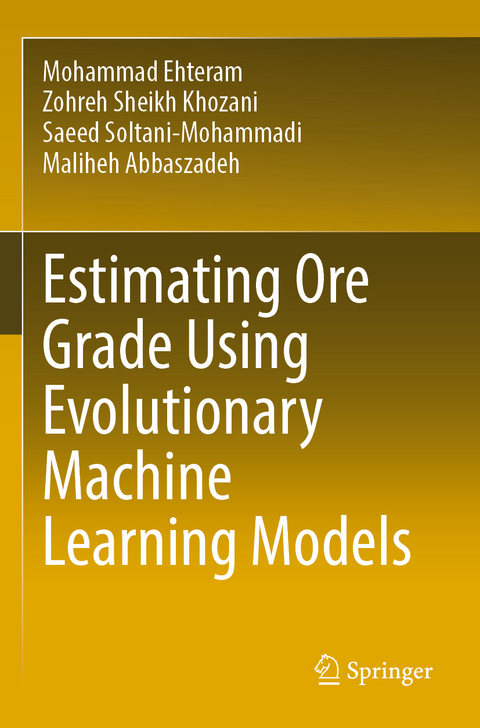
Estimating Ore Grade Using Evolutionary Machine Learning Models
Springer Verlag, Singapore
978-981-19-8108-1 (ISBN)
This book examines the abilities of new machine learning models for predicting ore grade in mining engineering. A variety of case studies are examined in this book. A motivation for preparing this book was the absence of robust models for estimating ore grade. Models of current books can also be used for the different sciences because they have high capabilities for estimating different variables. Mining engineers can use the book to determine the ore grade accurately. This book helps identify mineral-rich regions for exploration and exploitation. Exploration costs can be decreased by using the models in the current book. In this book, the author discusses the new concepts in mining engineering, such as uncertainty in ore grade modeling. Ensemble models are presented in this book to estimate ore grade. In the book, readers learn how to construct advanced machine learning models for estimating ore grade. The authors of this book present advanced and hybrid models used to estimate oregrade instead of the classic methods such as kriging. The current book can be used as a comprehensive handbook for estimating ore grades. Industrial managers and modelers can use the models of the current books. Each level of ore grade modeling is explained in the book. In this book, advanced optimizers are presented to train machine learning models. Therefore, the book can also be used by modelers in other fields. The main motivation of this book is to address previous shortcomings in the modeling process of ore grades. The scope of this book includes mining engineering, soft computing models, and artificial intelligence.
Mohammad Ehtearm is a Researcher in the field of artificial intelligence. He has a Ph.D. in civil engineering. His research interests generally lie in the areas application of remote sensing in water resources, water, energy, and food nexus, extreme hydrological events, river engineering, remote sensing in water resources, dam and hydropower operation, geotechnical engineering, mining engineering, artificial intelligence, and remote sensing in mining engineering. Zohreh Sheikh Khozani is a Scientific Researcher in the field of civil engineering and mining engineering. The scope of her current research is covering hydraulic structures, hydrology, water resources engineering, environmental engineering, and the implementation of data analytics, geotechnical engineering, mining engineering, and artificial intelligence models. Saeed Soltani-Mohammadi is Associate Professor at Department of Mining Engineering, University of Kashan, Iran. He holds a PhD on mining engineering from the Amirkabir University of technology in 2009. His research spans application of artificial intelligence and optimization methods in geosciences and mining problems. He developed many soft computing models based on practical applications for mining engineering. Maliheh Abbaszadeh is Assistant Professor at Department of Mining Engineering, University of Kashan, Iran. She holds a Ph.D. in mining engineering from the Amirkabir University of technology in 2014. She developed her teaching activity in the areas of geochemical exploration, remote sensing and machine learning algorithms. Her primary research interest is application of machine learning algorithms in exploratory data analysis.
Explains the importance of ore grade estimation.- Reviews machine learning models for ore grade estimation.- Explains the structure of different kinds of machine learning models.- Explains different training algorithms and optimization algorithms. This chapter also explains the structure of evolutionary machine learning models.- Explains the Bayesian model averaging and multilayer perceptron networks for estimating AL2O3 grade in a mine.- Explains the structure of inclusive multiple models and optimized radial basis function neural networks for estimating Sio2 grade in a mine.- Explains the application of hybrid kriging and extreme learning machine models for estimating copper ore grade in a mine.- Explains the application of optimized group machine data handling, support vector machines, and Adaptive neuro-fuzzy interface systems for estimating iron ore grade in mines.- Presents the conclusion, general comments, and suggestions for the next books.
| Erscheinungsdatum | 30.12.2023 |
|---|---|
| Zusatzinfo | 39 Illustrations, color; 6 Illustrations, black and white; XIII, 101 p. 45 illus., 39 illus. in color. |
| Verlagsort | Singapore |
| Sprache | englisch |
| Maße | 155 x 235 mm |
| Themenwelt | Mathematik / Informatik ► Informatik ► Datenbanken |
| Informatik ► Theorie / Studium ► Algorithmen | |
| Informatik ► Theorie / Studium ► Künstliche Intelligenz / Robotik | |
| Naturwissenschaften ► Geowissenschaften ► Geologie | |
| Naturwissenschaften ► Geowissenschaften ► Mineralogie / Paläontologie | |
| Schlagworte | Al2O3 • bayesian model • ensemble models • Machine Learning Models • optimization algorithms • Ore Grade Estimation • SiO2 |
| ISBN-10 | 981-19-8108-6 / 9811981086 |
| ISBN-13 | 978-981-19-8108-1 / 9789811981081 |
| Zustand | Neuware |
| Haben Sie eine Frage zum Produkt? |
aus dem Bereich


